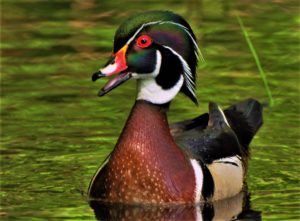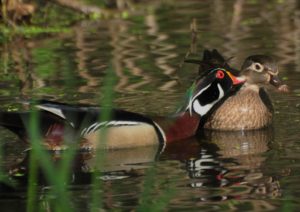Photography courtesy of Lowell Washburn, all rights reserved.
To say that wood ducks make interesting photo subjects is like saying Mt. Everest is tall; that lava is hot.
With its streamlined form, multicolored plumage, and elegantly crested head, the wood duck is one of our most beautiful birds – the Beau Brummel of American waterfowl. Getting a good look at one is not easy. Shy and reclusive, wood ducks are rarely seen on open water. Instead, they prefer the seclusion of tangled willow sloughs, densely wooded river bottoms, and cattail choked marshlands.
Wood ducks are incredibly wary, melting into the scenery at the first hint of danger. Obtaining good photos is always a challenge. To succeed you must become completely invisible. Becoming invisible isn’t as tough as it sounds. The simplest and most effective method is to seek concealment within a shoreline or — better yet — floating blind.
The nesting season is one of my favorite times to be in the blind. Wood duck observation is an adventure in bird study. When compared to other waterfowl, wood ducks have an amazingly complex social structure. Woodies possess an extensive vocabulary and there is near constant interaction among pairs. Many of the widely varied sounds are low in volume and can only be heard at close range. Males also engage in a wide range of enthusiastic communications. One of their most unique calls is a hissing “pssst, pssst” used to acknowledge the arrival of new birds. When uttering this call, the drake simultaneously raises and bobs his head while elevating his mane-like crest. Wood ducks are never showier than when greeting strangers.
Another unique interaction is an endearing activity known allopreening. During this display, the drake gently preens the head and neck feathers of his mate. Allopreening demonstrates mutual acceptance and strengthens already established pair bonds.



 Tom Cope
Tom Cope Sue Wilkinson
Sue Wilkinson Susan Judkins Josten
Susan Judkins Josten Rudi Roeslein
Rudi Roeslein Elyssa McFarland
Elyssa McFarland Mark Langgin
Mark Langgin Adam Janke
Adam Janke Joe Henry
Joe Henry Kristin Ashenbrenner
Kristin Ashenbrenner Joe Wilkinson
Joe Wilkinson Dr. Tammy Mildenstein
Dr. Tammy Mildenstein Sean McMahon
Sean McMahon